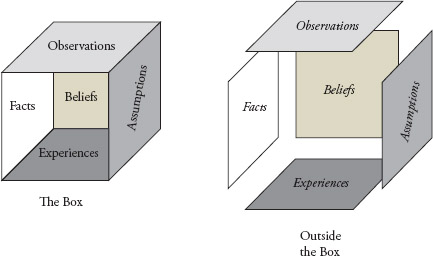27 Outside-the-Box Thinking
“We need to think outside the box!” someone passionately shouts during a meeting. The statement conveys the sense that the current thinking isn't yielding satisfactory solutions. Either they're not unique enough, or they won't produce the desired results.
When I hear this statement, I always ask, “What's outside the box?” The responses I get typically involve “away from the norm,” “new and improved,” “innovative,” “radical,” “no constraints,” and “no preconceived notions.” I nod and ask, “But what is the norm? What's the normal way we reach solutions?”
I'm happy to say that someone in our workshops usually remembers the prior hours' teachings and says, “Inductive reasoning, a premise yields conclusions. Facts, observations, experiences, beliefs, and assumptions.”
I rejoice, “Yes!”
Your box is bound by your facts, observations, experiences, beliefs, and assumptions, so if you want to think outside of it, you have to think outside those boundaries. You'll still be using inductive reasoning, but with new or modified premise elements. You do this, as shown Figure 27.1, by pushing those boundaries.

Figure 27.1 The Box
Try the puzzle shown in Figure 27.2. (You may wish to copy this page so that you don't give away the solution to someone who may read this book after you.) Place your pen or pencil on one of the dots, and without lifting your pen or pencil ...
Get Think Smarter: Critical Thinking to Improve Problem-Solving and Decision-Making Skills now with the O’Reilly learning platform.
O’Reilly members experience books, live events, courses curated by job role, and more from O’Reilly and nearly 200 top publishers.

